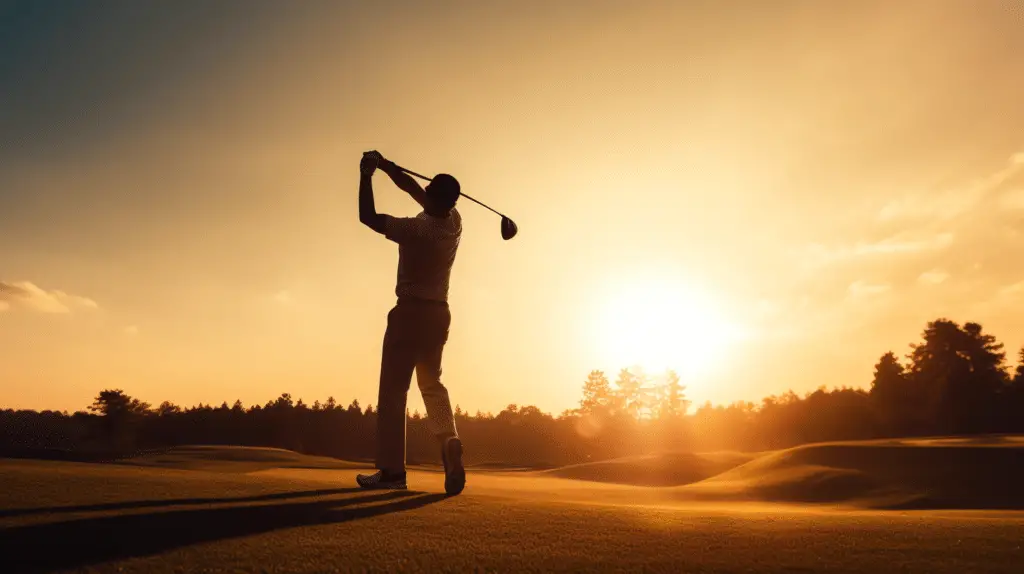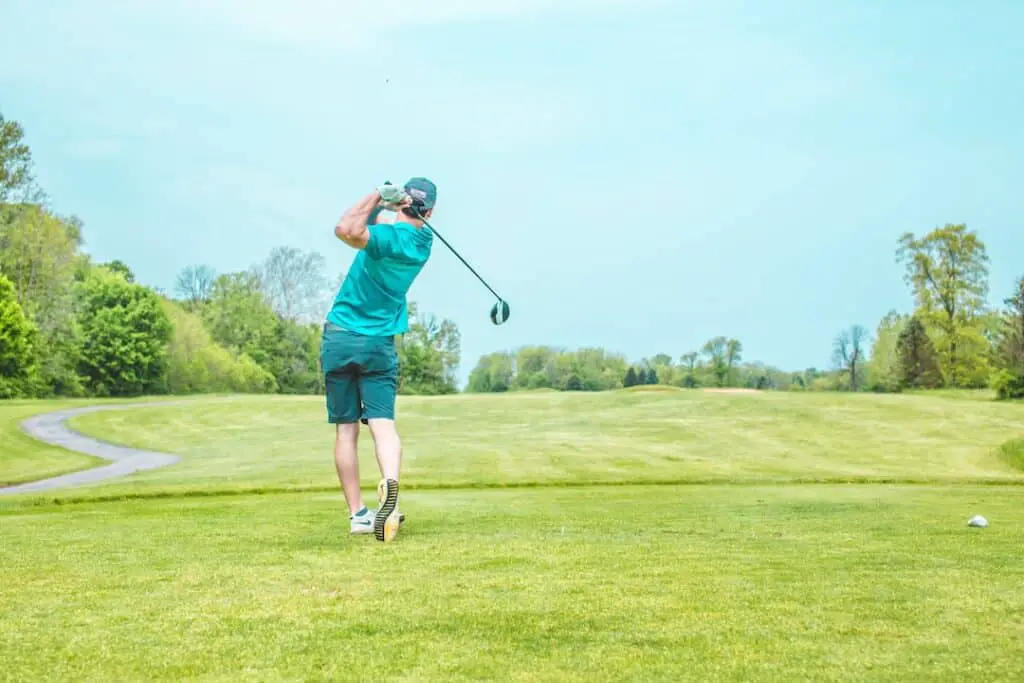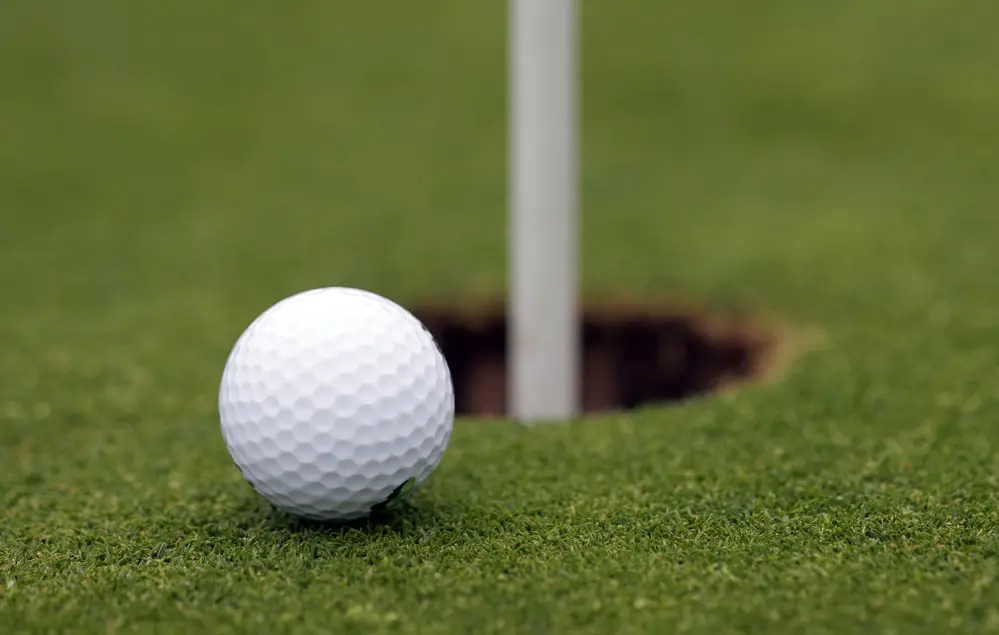Last Updated on June 13, 2023
Golf is a challenging and rewarding game that can often be difficult to master. Many golfers face the same problem of hitting their balls too high, leading to shots that lack accuracy and distance. In this article, we will look at why some players hit the ball so high and what they can do to improve their technique.
Improper Swing Path
It’s likely that your golf ball is being hit too high because of an improper swing path. This could be due to incorrect timing, an unbalanced stance, or even overswinging.
When your timing isn’t right, it can cause you to come up out of the shot instead of down through it. Additionally, if your stance is off-balance, there may be a tendency to lift rather than dive into the shot, which will also result in a higher trajectory. If you are swinging too hard and not allowing yourself enough time to complete the follow-through then again, this will lead to more backspin and, ultimately, a higher flight path for the ball.
To rectify these issues, practice taking slow swings while focusing on keeping good form throughout each step of the process: address, take away, top and finish with a balanced waist turn. When done correctly, this should help lower your shots significantly.
Incorrect Clubface Alignment
One of the primary reasons why golfers hit the ball too high is incorrect clubface alignment. This can be caused by an incorrect setup, stance, or timing when performing a shot. If you are not setting up correctly before a swing, your chances of hitting the ball too high will increase significantly.
Incorrect setups include:
- Not positioning yourself properly in relation to the target line
- Aligning your body away from the target instead of directly towards it
- Placing more weight on one foot than the other
Furthermore, having an incorrect stance and poor timing can also lead to a higher flight path for the ball. Incorrect stances involve adopting an unnatural posture that does not support smooth movement during the backswing and follow through. Poor timing refers to starting your swing too early or late, which causes issues with finding proper contact between the clubface and the golf ball.
To avoid these mistakes, ensure that you have established the correct form prior to making any swings. Get into position slowly and deliberately so as not to rush or compromise your technique; this will give you greater control over how far and high you hit each shot.
Weak Grip

A loose grip can be just as detrimental to the quality of your swing and shot trajectory as an incorrectly aligned face. When gripping the golf club too lightly, a golfer’s stance tends to become weaker than usual as they compensate for their lack of control over the club by shifting weight around, searching for stability. Additionally, with such a loose hold comes a shallower angle in which you bring the club back before launching it forward at impact. This will cause both power and accuracy issues when attempting shots off the tee or out of rough terrain.
A strong grip is essential if you are aiming for consistent ball striking – this means holding onto the golf club firmly but not so tight that movement becomes impossible. If your hands feel like they are about to slip away from one another during your practice swings, then chances are your grip strength needs some work. Such tension should allow for maximum control without compromising flexibility and comfort within your stance. It is also important to note that different types of clubs may require slightly varying grips depending on what type of shot you plan on playing next; subtle changes such as these should be taken into account throughout each round of golf in order to make sure you hit every shot with confidence and consistency.
Ultimately, making small adjustments in both how tightly you grip and how deep the angle between your arm and torso is when swinging through impact can have huge implications when looking at overall performance results on course – recognizing this early could save time down range once more difficult courses begin requiring further finesse out of each player’s individual game-planning strategy. To ensure success in any part of the game, creating habits centered around proper technique is key – starting with fundamental fundamentals like correct posture and optimal hand placement could very well set up aspiring players for lifelong enjoyment out on the links!
Poor Posture
Poor posture is a common cause of why some golfers hit the ball too high. When poor posture is present, excess tension can quickly build up in and around the body as one attempt to make contact with the ball. This tension will often lead to an improper balance being maintained throughout the swing, resulting in a lack of power or direction control.
In addition, having incorrect posture during a golf shot can also prevent your hips from unwinding properly at impact. Without this free-flowing rotation of the hips, it becomes difficult for you to gain any extra yards on the fairway. The result is that many shots end up soaring higher than desired due to inadequate clubhead speed combined with a downward strike angle when making contact with the ball.
Therefore, by maintaining correct posture while taking your shot, you will be able to generate more power and accuracy off each tee, helping reduce those pesky high shots along the way! With proper practice and patience, you can soon have faith in every drive taken down the fairway, knowing full well where it’s going and how far it should travel.
Uneven Weight Distribution
One of the main reasons why your golf ball is hitting too high could be due to an uneven weight distribution during the swing. This can often be caused by incorrect footwork, such as having your feet too far apart or failing to keep them in a steady position throughout the motion. Furthermore, an improper stance when preparing for the shot can also lead to this issue; if you’re standing too close to or too far away from the ball, it will affect how much loft you impart on the club head at impact.
In addition, using a driver with too much loft can also result in higher shots than intended. If you have a driver that has twelve degrees of loft and above, it’s likely that you’ll find yourself consistently getting more height on your tee shots than desired. In these situations, it may be worth switching out for another model or opting for one with less loft so that you can get better consistency off the tee box.
Finally, understanding what aspects of your form are causing issues with your drives is crucial in order to make adjustments and improve your game overall. Taking time to practice proper footwork and stance before each shot will ensure that you don’t suffer from discrepancies which can cause unwanted trajectory changes mid-swing – resulting ultimately in higher shots than necessary.
Slowing Down Your Swing

Having an uneven weight distribution can be a major cause of why you hit the golf ball so high. Unfortunately, this isn’t the only factor that could potentially contribute to your problem. To understand and address the issue further, it is important to look at other elements in play, such as incorrect swing tempo, stance and set up.
Firstly, let’s turn our attention to the swing tempo. It is essential for a golfer to maintain a consistent rhythm when they are swinging their club. If you have an inconsistent swing tempo, then it is likely that you will struggle with making solid contact on the ball, resulting in increased heights off the tee box. Therefore, try counting out or using a metronome to keep track of your timing during practice swings.
The next element we must consider is posture and setup. An incorrect stance may lead to poor balance, which could result in shallow angles of attack, causing shots to fly higher than usual. Additionally, if your grip pressure is too tight, then it can add tension throughout your body leading to erratic results from shot to shot. Here are three tips for improving both:
- Keep feet shoulder width apart and ensure hips remain parallel with shoulders
- Make sure arms are relaxed yet still connected firmly on either side of the body
- Aim for even weight distribution through each foot as opposed to shifting more weight onto one side
Finally, remember that mastering these elements takes time and patience, but once achieved, you should see improved accuracy and distance control off the tee box! In order to make progress quickly, focus on practising drills regularly while focusing solely on technique rather than trying aimlessly without any direction or intentionality behind each shot.
Improper Ball Positioning
Another factor influencing why you’re hitting the ball so high could be due to your shaft flex. Fitting yourself properly with the right type of club can greatly improve performance as well as swing tempo. Generally speaking, if you find yourself swinging slower than average, then selecting clubs with stiffer shafts may reduce backspin on impact, thus resulting in lower flight trajectory off the tee. On the other hand, faster swingers should consider more flexible shafts which generate greater loft at impact, allowing shots to go higher into the air without sacrificing distance.
To hit longer drives consistently requires practice and patience but making minor adjustments such as proper weight distribution and choosing clubs tailored towards individual playing styles are essential components in helping optimize overall results on the course. With dedicated practice and keen awareness towards body position during setup phase, along with finding optimal equipment fitment suited for personal playing style, one can significantly improve their game from tee-to-green all around!
Conclusion
In conclusion, when it comes to hitting a golf ball lower, posture and grip are key. Ensuring that you have the correct posture with your arms in line with your shoulders and knees slightly bent can help reduce excessive height on your shots. Additionally, having an appropriate grip will ensure the clubface is square to the target at impact, which should also help keep your ball flight low. Finally, making sure your weight distribution is even throughout the swing will create a smooth transition from backswing to downswing and result in more consistent contact with the ball. By following these simple steps, I’m confident you’ll be able to hit those perfect low-flying shots!



